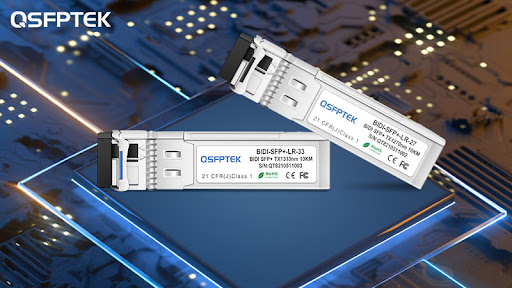Since 2013, the application of SFP transceiver modules has become more and more extensive. Regular SFP modules are equipped with a Duplex interface and use two fibers to transmit data. One fiber is used to send data and the other is used to receive data. In order to save fiber resources, technicians have invented a new type of SFP transceiver – bidirectional SFP (BiDi SFP) transceiver, which can send and receive data to interconnected devices through a single fiber. This article will introduce the BiDi SFP transceiver module and china transceiver manufactuer.
What is bidi sfp?
A bidirectional SFP (Bi-Di SFP) is a type of SFP transceiver that can transmit and receive data on a single fiber link. Bi-Di SFPs are commonly used in Ethernet and Fiber Channel applications. There are two main types of Bi-Di SFPs: duplex and simplex. Duplex Bi-Di SFPs have two LC connectors, while simplex Bi-Di SFPs have one LC connector.
The main advantage of using a Bi-Di SFP is that it requires only one fiber link to establish bidirectional communication. This can simplify the cabling infrastructure and save on hardware costs. However, Bi-Di SFPs typically have a lower data rate than conventional SFPs.
When choosing a Bi-Di SFP, it is essential to select a device that is compatible with the equipment it will be used with. For example, if the equipment uses an LC interface, then the Bi-Di SFP must also have an LC interface. It is also essential to check the data rate and wavelength compatibility. In general, it is best to choose a Bi-Di SFP from the same manufacturer as the equipment it will be used with.
Differences Between BiDi SFP and Normal duplex SFP
A BiDi SFP transceiver is fitted with wavelength division multiplexing (WDM) couplers, which combine and separate data transmitted over a single fiber based on the wavelengths of the light. This means that BiDi SFP has only one port, while the traditional SFP module generally has two ports – one for transmitting data (TX), and the other for receiving data (RX). The single-fiber nature of BiDi SFP can help save fiber resources when compared to traditional duplex SFP transceivers. In addition, the use of WDM couplers enables BiDi SFP to support bidirectional communication over a single optical fiber. This can simplify network deployments and reduce costs associated with running extra optical fibers.
Another difference between regular SFP and BiDi SFP is the optical subassembly, which is the main cost component of fiber optic transceivers. As we all know, a common SFP usually has two optical sub-assemblies: a transmitting optical sub-assembly (TOSA) and a receiving optical sub-assembly (ROSA). However, BiDi SFP transmits and receives data on a single waveguide, which means it only has one optical sub-assembly. Therefore, it can save fiber resources compared to traditional two-fiber modules because only one strand of single mode or multimode fiber is needed to implement a point-to-point link.
In addition to saving fiber resources, the use of BiDi optics can also simplify cable routing and eliminate the need fortx/rx connectors at patch panels. This allows for a reduced number of cable paths and improved airflow within data center cabinets. All these make BiDi optics an attractive solution for high density applications such as 10 Gigabit Ethernet in data centers.
Best BIDI SFP Provider
Let me introduce a long-established company. Ecloudlight is a Chinese optical module provider. It provides high-quality and inexpensive optical module products, if you want to know more, you can contact us.













